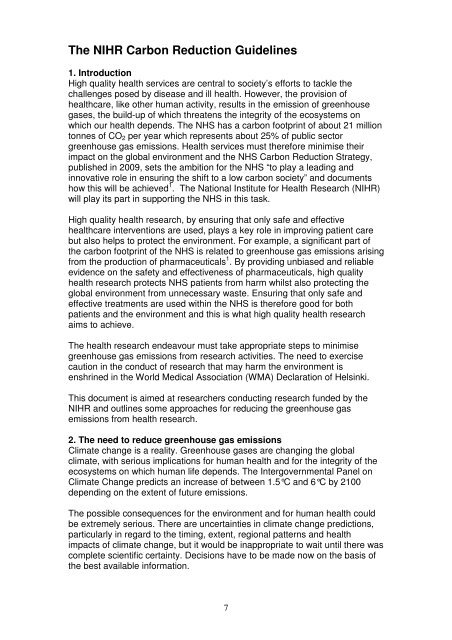The NIHR Carbon Reduction Guidelines
The NIHR Carbon Reduction Guidelines
The NIHR Carbon Reduction Guidelines
Create successful ePaper yourself
Turn your PDF publications into a flip-book with our unique Google optimized e-Paper software.
<strong>The</strong> <strong>NIHR</strong> <strong>Carbon</strong> <strong>Reduction</strong> <strong>Guidelines</strong>1. IntroductionHigh quality health services are central to society’s efforts to tackle thechallenges posed by disease and ill health. However, the provision ofhealthcare, like other human activity, results in the emission of greenhousegases, the build-up of which threatens the integrity of the ecosystems onwhich our health depends. <strong>The</strong> NHS has a carbon footprint of about 21 milliontonnes of CO 2 per year which represents about 25% of public sectorgreenhouse gas emissions. Health services must therefore minimise theirimpact on the global environment and the NHS <strong>Carbon</strong> <strong>Reduction</strong> Strategy,published in 2009, sets the ambition for the NHS “to play a leading andinnovative role in ensuring the shift to a low carbon society” and documentshow this will be achieved 1 . <strong>The</strong> National Institute for Health Research (<strong>NIHR</strong>)will play its part in supporting the NHS in this task.High quality health research, by ensuring that only safe and effectivehealthcare interventions are used, plays a key role in improving patient carebut also helps to protect the environment. For example, a significant part ofthe carbon footprint of the NHS is related to greenhouse gas emissions arisingfrom the production of pharmaceuticals 1 . By providing unbiased and reliableevidence on the safety and effectiveness of pharmaceuticals, high qualityhealth research protects NHS patients from harm whilst also protecting theglobal environment from unnecessary waste. Ensuring that only safe andeffective treatments are used within the NHS is therefore good for bothpatients and the environment and this is what high quality health researchaims to achieve.<strong>The</strong> health research endeavour must take appropriate steps to minimisegreenhouse gas emissions from research activities. <strong>The</strong> need to exercisecaution in the conduct of research that may harm the environment isenshrined in the World Medical Association (WMA) Declaration of Helsinki.This document is aimed at researchers conducting research funded by the<strong>NIHR</strong> and outlines some approaches for reducing the greenhouse gasemissions from health research.2. <strong>The</strong> need to reduce greenhouse gas emissionsClimate change is a reality. Greenhouse gases are changing the globalclimate, with serious implications for human health and for the integrity of theecosystems on which human life depends. <strong>The</strong> Intergovernmental Panel onClimate Change predicts an increase of between 1.5°C and 6°C by 2100depending on the extent of future emissions.<strong>The</strong> possible consequences for the environment and for human health couldbe extremely serious. <strong>The</strong>re are uncertainties in climate change predictions,particularly in regard to the timing, extent, regional patterns and healthimpacts of climate change, but it would be inappropriate to wait until there wascomplete scientific certainty. Decisions have to be made now on the basis ofthe best available information.7

















